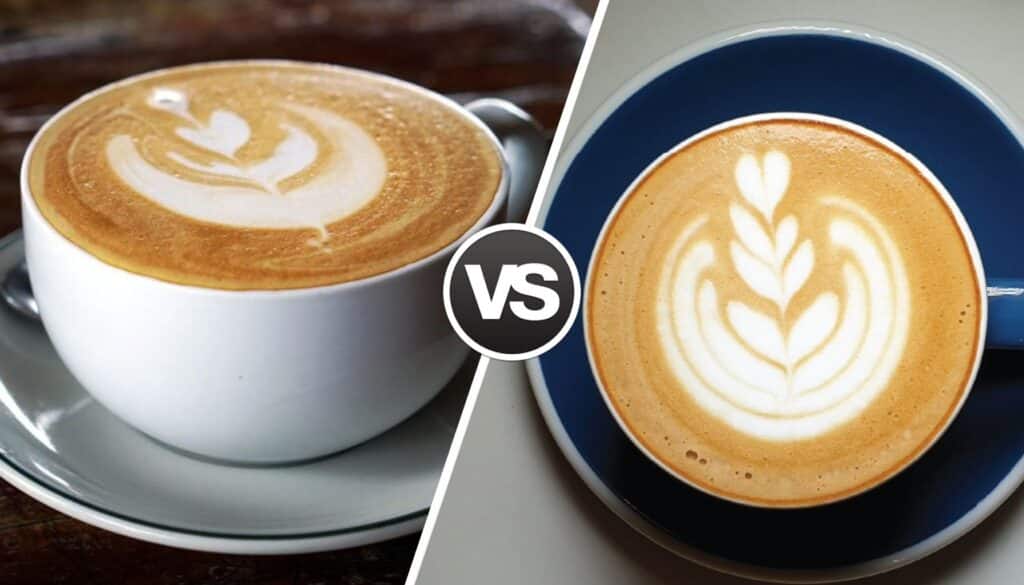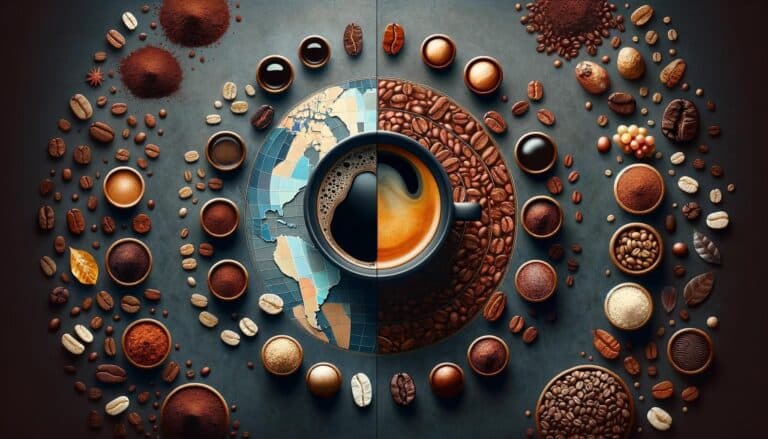Coffee lovers often find themselves caught in the delightful dilemma of choosing between a latte and a cappuccino. Both of these espresso-based beverages hold their unique charm and characteristics, but understanding the key differences can help you make the perfect choice to suit your taste buds and mood. Let’s dive into the world of lattes and cappuccinos, exploring their origins, preparation methods, and what makes each one distinct.
The Basics: Latte and Cappuccino Defined
A latte, also known as a café latte, is a popular coffee drink made with a shot of espresso and steamed milk, topped with a small layer of milk foam. The word “latte” means milk in Italian, indicating that milk plays a significant role in this beverage. On the other hand, a cappuccino consists of equal parts of espresso, steamed milk, and milk foam, creating a well-balanced drink with a rich, creamy texture and a strong coffee flavor.
The main difference between a latte and a cappuccino lies in the ratio of milk to espresso and the texture of the foam. While a latte has more steamed milk and a light layer of foam, a cappuccino features a thicker layer of milk foam and less steamed milk, resulting in a stronger coffee taste.

Origins and Cultural Significance
The latte and cappuccino have rich histories that reflect their cultural origins. The latte, though an Italian term, has its modern roots in American coffee culture. It became popular in the United States, particularly in the coffeehouses of California. The cappuccino, on the other hand, hails from Italy and has been a staple in Italian cafés for decades.
In Italy, cappuccinos are traditionally consumed in the morning and are rarely enjoyed after 11 AM. The drink’s name is derived from the Capuchin friars, referring to the color of their robes, which resembles the coffee and milk mixture. Meanwhile, the latte has evolved to include various flavors and milk alternatives, making it a versatile and widely enjoyed beverage across the globe.
Preparation Techniques
The preparation of a latte and a cappuccino requires skill and precision, particularly in handling the milk and espresso. Here’s a step-by-step guide on how each is made:
Latte Preparation:
- Espresso: Start with a single or double shot of espresso, depending on your preference.
- Steamed Milk: Steam a generous amount of milk until it reaches a creamy consistency. The ideal temperature for steaming milk is around 150°F to 160°F.
- Pouring: Pour the steamed milk into the espresso, creating a harmonious blend. Top it off with a light layer of milk foam. Baristas often add artistic touches known as latte art, creating intricate patterns on the surface of the drink.
Cappuccino Preparation:
- Espresso: Begin with a single or double shot of espresso.
- Steamed Milk and Foam: Steam a smaller amount of milk, ensuring it becomes frothy and thick. The goal is to create microfoam, which is essential for a cappuccino.
- Layering: First, pour the steamed milk into the espresso, followed by the thick layer of milk foam. The perfect cappuccino has distinct layers of espresso, milk, and foam.
Taste and Texture
The differences in preparation result in distinct taste and texture profiles for lattes and cappuccinos. A latte is smooth and creamy, with a milder coffee flavor due to the higher milk content. This makes it an excellent choice for those who prefer a less intense coffee taste and enjoy experimenting with different flavors such as vanilla, caramel, or hazelnut.
A cappuccino, in contrast, offers a bolder coffee experience. The equal parts of espresso, steamed milk, and foam create a rich and velvety texture, with the foam adding a luxurious mouthfeel. The strong coffee flavor is perfect for those who appreciate a more robust taste in their espresso drinks.
Health Considerations
When it comes to health and calorie content, the choice between a latte and a cappuccino depends on your dietary preferences. Generally, a cappuccino contains fewer calories than a latte due to the lower milk content. For instance, a 12-ounce cappuccino made with whole milk typically has around 130 calories, whereas a latte of the same size can have approximately 210 calories.
However, both drinks can be customized to fit your dietary needs. Using non-fat milk or plant-based alternatives such as almond, soy, or oat milk can significantly reduce the calorie content. Additionally, flavor syrups and sweeteners can add extra calories, so it’s essential to consider these additions when making your choice.
Versatility and Variations
The versatility of lattes and cappuccinos allows for numerous variations, catering to diverse tastes and preferences. Lattes, in particular, have become a canvas for creativity, with baristas experimenting with different flavors and ingredients. Some popular latte variations include:
- Caramel Latte: A sweet and indulgent version with caramel syrup.
- Mocha Latte: A delightful blend of chocolate and coffee.
- Vanilla Latte: A classic choice with a touch of vanilla flavor.
- Pumpkin Spice Latte: A seasonal favorite with spices like cinnamon, nutmeg, and cloves.
Cappuccinos, while more traditional, also offer variations such as the “dry cappuccino,” which has more foam and less steamed milk, and the “wet cappuccino,” which has more steamed milk and less foam. In Italy, cappuccinos are sometimes topped with a sprinkle of cocoa powder or cinnamon for added flavor.
The Experience: Hot vs. Cold
Both lattes and cappuccinos can be enjoyed hot or cold, adding to their appeal. An iced latte is a refreshing option for warm weather, made by pouring espresso over ice and adding cold milk. Similarly, an iced cappuccino features chilled espresso with frothed cold milk, creating a creamy yet refreshing beverage.
The hot versions of these drinks provide comfort and warmth, making them ideal for cooler months. The texture and flavor profiles remain consistent, whether hot or cold, ensuring a delightful coffee experience year-round.
Conclusion
Choosing between a latte and a cappuccino ultimately comes down to personal preference. If you enjoy a creamy, milky coffee with the option to explore various flavors, a latte is your best bet. On the other hand, if you prefer a stronger coffee taste with a rich and frothy texture, a cappuccino is the way to go.
Both beverages offer a unique and enjoyable coffee experience, making them beloved choices for coffee enthusiasts worldwide. Whether you opt for a latte or a cappuccino, you can’t go wrong with either of these delightful espresso-based drinks. So, the next time you find yourself at a café, order with confidence and savor the perfect cup of coffee tailored to your taste.
Frequently Asked Questions (FAQs) about Lattes and Cappuccinos
What is the primary difference between a latte and a cappuccino?
The primary difference lies in the milk-to-espresso ratio. A latte has more steamed milk and a light layer of foam, while a cappuccino features equal parts espresso, steamed milk, and a thick layer of milk foam.
Which drink is stronger in terms of coffee flavor?
A cappuccino has a stronger coffee flavor due to the lower amount of milk and the presence of a thick foam layer, which enhances the espresso taste.
Can both lattes and cappuccinos be served cold?
Yes, both drinks can be enjoyed hot or cold. Iced lattes are made with chilled milk and espresso over ice, while iced cappuccinos include frothed cold milk and espresso over ice.
Are there any variations of lattes and cappuccinos?
Yes, lattes can be customized with various flavors like vanilla, caramel, mocha, and seasonal spices. Cappuccinos can also have variations like dry cappuccinos (more foam) and wet cappuccinos (more steamed milk).
Which is healthier, a latte or a cappuccino?
Generally, cappuccinos are lower in calories due to less milk content. However, using non-fat or plant-based milk alternatives can adjust the calorie content for both drinks.
Can I create latte art with both drinks?
Latte art is typically done with lattes due to their smooth, less foamy top layer, which allows baristas to create intricate patterns. Cappuccinos, with their thicker foam, are less suited for latte art.
How do the origins of lattes and cappuccinos differ?
Lattes, though an Italian term, have modern roots in American coffee culture. Cappuccinos originate from Italy and are traditionally consumed in the morning.
What is the best milk to use for lattes and cappuccinos?
Both drinks can be made with various types of milk, including whole milk, 2% milk, non-fat milk, and plant-based alternatives like almond, soy, and oat milk. The choice of milk can affect the texture and flavor of the drink.
How do the textures of lattes and cappuccinos compare?
Lattes have a smooth and creamy texture with a small amount of foam on top, while cappuccinos have a rich, velvety texture with a thick layer of foam.
Which drink should I choose if I prefer a sweeter coffee?
Lattes are generally considered sweeter and milkier, especially when flavored syrups like vanilla, caramel, or hazelnut are added. Cappuccinos, with their stronger coffee taste, are less sweet unless flavored.






